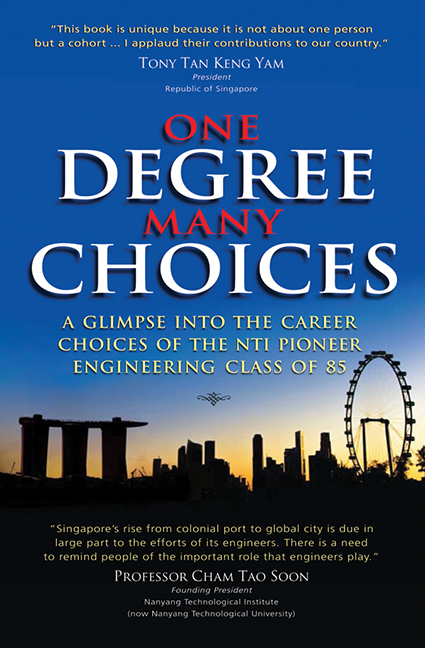 One Degree, Many Choices
One Degree, Many Choices Book contents
- Frontmatter
- Contents
- WHAT THIS BOOK IS ABOUT
- FOREWORD
- ACKNOWLEDGEMENTS
- INTRODUCTION It's All About Life Choices
- PART I THE BEGINING
- PART II ENGINEERING PURSUITS
- CHAPTER 4 Riding High on Semiconductors
- CHAPTER 5 Thriving in the Chemical Industry
- CHAPTER 6 Navigating the Marine Industry
- CHAPTER 7 Rise & Decline of the Disk Drive Industry
- CHAPTER 8 Boom & Bust in the Electronics Industry
- CHAPTER 9 Leading Lights in the IT Industry
- CHAPTER 10 Riding the Ups & Downs in the Telecommunications Industry
- CHAPTER 11 Transporting the Masses
- CHAPTER 12 Providing Electricity & Gas to Singaporeans
- CHAPTER 13 Environment Engineering & Inventions
- CHAPTER 14 Building Infrastructure & Housing Millions
- CHAPTER 15 Building Jewels In & Out of Singapore
- CHAPTER 16 Soaring in Aerospace
- CHAPTER 17 Banking on the Emerging Life Sciences Industry
- CHAPTER 18 Making Waves in Other Industries
- CHAPTER 19 Growing Singapore Inc through Government-Linked Companies
- CHAPTER 20 Defending Our Nation
- CHAPTER 21 Moulding Future Leaders
- CHAPTER 22 Training Engineers at the Frontline
- CHAPTER 23 The CSE Entrepreneurs
- CHAPTER 24 Technopreneurs from EEE
- CHAPTER 25 MPE Graduates Who Became Their Own Boss
- PART III THE LADY ENGINEERS
- PART IV NON-ENGINEERING PURSUITS
- PART V EPILOGUE
- APPENDICES
- THE SUPPORT TEAM
CHAPTER 11 - Transporting the Masses
from PART II - ENGINEERING PURSUITS
Published online by Cambridge University Press: 21 October 2015
- Frontmatter
- Contents
- WHAT THIS BOOK IS ABOUT
- FOREWORD
- ACKNOWLEDGEMENTS
- INTRODUCTION It's All About Life Choices
- PART I THE BEGINING
- PART II ENGINEERING PURSUITS
- CHAPTER 4 Riding High on Semiconductors
- CHAPTER 5 Thriving in the Chemical Industry
- CHAPTER 6 Navigating the Marine Industry
- CHAPTER 7 Rise & Decline of the Disk Drive Industry
- CHAPTER 8 Boom & Bust in the Electronics Industry
- CHAPTER 9 Leading Lights in the IT Industry
- CHAPTER 10 Riding the Ups & Downs in the Telecommunications Industry
- CHAPTER 11 Transporting the Masses
- CHAPTER 12 Providing Electricity & Gas to Singaporeans
- CHAPTER 13 Environment Engineering & Inventions
- CHAPTER 14 Building Infrastructure & Housing Millions
- CHAPTER 15 Building Jewels In & Out of Singapore
- CHAPTER 16 Soaring in Aerospace
- CHAPTER 17 Banking on the Emerging Life Sciences Industry
- CHAPTER 18 Making Waves in Other Industries
- CHAPTER 19 Growing Singapore Inc through Government-Linked Companies
- CHAPTER 20 Defending Our Nation
- CHAPTER 21 Moulding Future Leaders
- CHAPTER 22 Training Engineers at the Frontline
- CHAPTER 23 The CSE Entrepreneurs
- CHAPTER 24 Technopreneurs from EEE
- CHAPTER 25 MPE Graduates Who Became Their Own Boss
- PART III THE LADY ENGINEERS
- PART IV NON-ENGINEERING PURSUITS
- PART V EPILOGUE
- APPENDICES
- THE SUPPORT TEAM
Summary
“If we did not use explosives, we might not finish the project on time.”
— Tan Kian Thong, CSE PioneerTHE SWEAT AND TOIL of Tan Kian Thong and Chua Chiow Chye have enabled Singaporeans to get to their workplaces in a speedy manner for more than two decades. These CSE pioneers helped build an indispensable part of our lives –– the Mass Rapid Transit (MRT) system. In 2009, the MRT network has an average daily ridership of two million. That is two in five residents.
The NTI pioneers’ engineering expertise was vital in creating the backbone of Singapore's public transport infrastructure. The MRT network is a source of national pride. It is the second-oldest metro system in Southeast Asia, after Manila's Light Rail Transit System. In 1985, the government rolled out the first MRT project known as the ‘Compass Line’ or North-South-East-West line.
“We constructed the sections linking the MRT stations at Chinese Garden, Lakeside and Boon Lay,” said Kian Thong. He and Chua Chiow Chye were site engineers with Mass Rapid Transit Corporation (MRTC), which later became SMRT Corporation.
The MRT system was the brainchild of the far-sighted Singapore government, who in 1967 foresaw the need for a more reliable mode of public transport as the population increased. They decided to have the network operational by 1992. The rationale was simple. An all-bus system was not viable due to limited space in a land-scarce country. The initial five-billion dollar construction of the MRT network was then Singapore's largest public works project. Construction began on 22 October 1983 at Shan Road and the network was built in stages. The North-South Line was built first as it passed through the Central Area that had a high demand for public transport. On 7 November 1987, the initial section between Yio Chu Kang Station and Toa Payoh Station began operations. Soon after, 15 more stations opened and then Prime Minister Lee Kuan Yew officially launched the MRT system on 12 March 1988. The opening of Boon Lay Station on the East West Line on 6 July 1990 marked the completion of the system two years ahead of schedule.
The MRT project was one of two bright spots –– the other was the HDB projects –– in the gloomy construction industry during the recession of 1985.
- Type
- Chapter
- Information
- One Degree, Many ChoicesA Glimpse into the Career Choices of the NTI Pioneer Engineering Class of 85, pp. 52 - 55Publisher: ISEAS–Yusof Ishak InstitutePrint publication year: 2012


